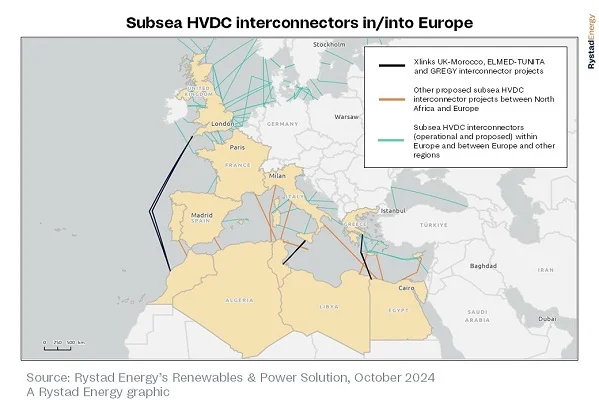Rystad Energy, a leading global independent research and energy intelligence company, has shown that Europe’s transition to a greener power sector is gaining speed, with North Africa is set to become a key enabler of this process
According to Rystad, 73% of Europe’s electricity will come from clean sources by 2035 and North Africa could potentially deliver up to 24GW of this through subsea interconnectors. Currently, Morocco is the only African country connected to Europe by two high-voltage cables to Spain (of 700MW), with a third planned in the near future. There are also further major projects in the offing, such as the Xlinks UK-Morocco project, which will establish a 11.5GW of intermittent renewable capacity, 22.5GWh of battery energy storage and a 3.6GW subsea interconnection between the two countries. Others are being pursued for alternative countries, principally the GREGY initiative between Greece and Egypt and the ELMED-TUNITA project between Tunisia and Italy.
Rystad suggests that these three initiatives coming online would see interconnector capacity rise to around 7.2GW, with 23GW of renewable capacity needing to be deployed in North Africa to support Europe. Its forecasts includes 13.5GW of solar and 9.5GW of onshore wind – projects that would require more than US$27.5bn in investment but would (when combined with the interconnectors operating at maximum capacity) potentially deliver 55TWh on an annual basis. This would represent 1.6% of Europe’s overall power generation currently.
"North Africa's renewable energy potential aligns well with Europe's goal of reducing reliance on Russian natural gas,” remarked Nivedh Das Thaikoottathil, senior analyst of renewables & power research at Rystad Energy. “The region’s geographic proximity makes it a natural fit for buyer-seller relationships, leading to large-scale solar and wind projects, along with subsea cables across the Mediterranean and even to the UK. Wind power in Europe peaks during the winter while solar power peaks in the summer, offering a chance to balance power supply fluctuations. This helps diversify energy sources and reduce fossil fuel use in Europe's power sector.”
There are currently more than 350GW of solar and wind projects in various stages of development across North Africa (most in concept phase); a testament to the well-suited environment of the region to renewables (which is already home to some of the largest solar and wind installations globally). According to Rystad, solar panels in North Africa can triple their yield compared to those in Europe due to the intensity of the sun there – photovoltaic power output ranges from 4.8 to 5.6kWh per kilowatt-peak, compared to 3.6 to 4.8kWh per kWp in Europe. North Africa also boasts significant wind potential, with wind speeds averaging between 7 to 10 meters per second.
Challenges ahead
The timely completion of renewable energy projects in North Africa is primarily hindered by supply chain constraints, reports Rystad. With limited local manufacturing capacity, the region must rely heavily on imports to meet its growing solar and wind energy demands. This dependency not only exposes North Africa to supply chain risks and price volatility, but also highlights a significant vulnerability in its energy strategy. Similar constraints are expected in the manufacturing and procurement of high-voltage direct current (HVDC) cables.
However, the availability of HVDC and extra-high-voltage (EHV) subsea cables will present significant challenges in the coming years. As of 2023, Europe produces more than 50% of these cables, with approximately 9,000 km currently in circulation globally. New manufacturing plants are anticipated to raise this supply to around 16,000 km by 2030. However, projections from Rystad Energy signal that demand will exceed 75,000 km by 2030, driven by the need for HVDC interconnectors and offshore wind export cables. This could create a supply-demand imbalance that necessitates intervention from Asian manufacturers, which will prompt European firms to urgently enhance their production capacity in order to meet demand.
In addition to these supply chain challenges, financing hurdles could further delay project timelines, particularly since many initiatives remain in the early development stages. Collaboration among multiple suppliers and contractors is crucial for completing cable fabrication and installation within the typical two to three-year timeframe. The concurrent development of solar PV and onshore wind projects will also help minimise delays and address issues related to cable integrity and storage costs.






















